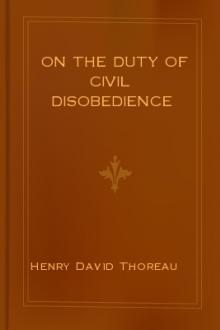Essays Henry David Thoreau (little bear else holmelund minarik .txt) 📖

- Author: Henry David Thoreau
Book online «Essays Henry David Thoreau (little bear else holmelund minarik .txt) 📖». Author Henry David Thoreau
By the twenty-sixth of October the large scarlet oaks are in their prime, when other oaks are usually withered. They have been kindling their fires for a week past, and now generally burst into a blaze. This alone of our indigenous deciduous trees (excepting the dogwood, of which I do not know half a dozen, and they are but large bushes) is now in its glory. The two aspens and the sugar-maple come nearest to it in date, but they have lost the greater part of their leaves. Of evergreens, only the pitch-pine is still commonly bright.
But it requires a particular alertness, if not devotion to these phenomena, to appreciate the widespread, but late and unexpected glory of the scarlet oaks. I do not speak here of the small trees and shrubs, which are commonly observed, and which are now withered, but of the large trees. Most go in and shut their doors, thinking that bleak and colorless November has already come, when some of the most brilliant and memorable colors are not yet lit.
This very perfect and vigorous one, about forty feet high, standing in an open pasture, which was quite glossy green on the twelfth, is now, the twenty-sixth, completely changed to bright dark scarlet—every leaf, between you and the sun, as if it had been dipped into a scarlet dye. The whole tree is much like a heart in form, as well as color. Was not this worth waiting for? Little did you think, ten days ago, that that cold green tree would assume such color as this. Its leaves are still firmly attached, while those of other trees are falling around it. It seems to say—“I am the last to blush, but I blush deeper than any of ye. I bring up the rear in my red coat. We scarlet ones, alone of oaks, have not given up the fight.”
The sap is now, and even far into November, frequently flowing fast in these trees, as in maples in the spring; and apparently their bright tints, now that most other oaks are withered, are connected with this phenomenon. They are full of life. It has a pleasantly astringent, acorn-like taste, this strong oak-wine, as I find on tapping them with my knife.
Looking across this woodland valley, a quarter of a mile wide, how rich those scarlet oaks, embosomed in pines, their bright red branches intimately intermingled with them! They have their full effect there. The pine-boughs are the green calyx to their red petals. Or, as we go along a road in the woods, the sun striking endwise through it, and lighting up the red tents of the oaks, which on each side are mingled with the liquid green of the pines, makes a very gorgeous scene. Indeed, without the evergreens for contrast, the autumnal tints would lose much of their effect.
The scarlet oak asks a clear sky and the brightness of late October days. These bring out its colors. If the sun goes into a cloud, they become comparatively indistinct. As I sit on a cliff in the southwest part of our town, the sun is now getting low, and the woods in Lincoln, south and east of me, are lit up by its more level rays; and in the scarlet oaks, scattered so equally over the forest, there is brought out a more brilliant redness than I had believed was in them. Every tree of this species which is visible in those directions, even to the horizon, now stands out distinctly red. Some great ones lift their red backs high above the woods, in the next town, like huge roses with a myriad of fine petals; and some more slender ones, in a small grove of white pines on Pine Hill in the east, on the very verge of the horizon, alternating with the pines on the edge of the grove, and shouldering them with their red coats, look like soldiers in red amid hunters in green. This time it is Lincoln green, too. Till the sun got low, I did not believe that there were so many red coats in the forest army. Theirs is an intense burning red, which would lose some of its strength, methinks, with every step you might take toward them; for the shade that lurks amid their foliage does not report itself at this distance, and they are unanimously red. The focus of their reflected color is in the atmosphere far on this side. Every such tree becomes a nucleus of red, as it were, where, with the declining sun, that color grows and glows. It is partly borrowed fire, gathering strength from the sun on its way to your eye. It has only some comparatively dull red leaves for a rallying-point, or kindling-stuff, to start it, and it becomes an intense scarlet or red mist, or fire, which finds fuel for itself in the very atmosphere. So vivacious is redness. The very rails reflect a rosy light at this hour and season. You see a redder tree than





Comments (0)